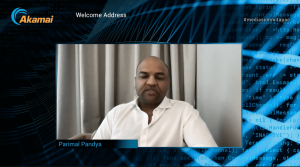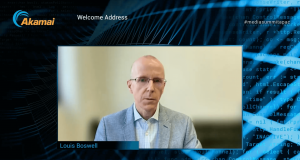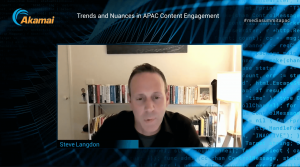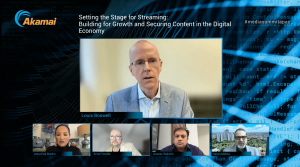
The Akamai Media Summit APAC Conference held virtually on 23 June highlighted the new trends that the video industry will see in the coming year in the Asia Pacific region and how media organizations can position themselves for greater success in the new normal.
The welcome address was led by Parimal Pandya, Akamai Technologies’ Managing Director of Asia Pacific and Japan and Louis Boswell, CEO of the Asia Video Industry Association (AVIA).

Parimal said, “There’s been a tremendous spike in the volume of attacks, the threat actors have gotten more active, we’ve seen almost two times or greater increase in attacks of all kinds on different properties [such as] video, gaming, and otherwise. I think that presents some really tough challenges for the industry that we need to figure out together.”
Meanwhile, Louis noted two key themes: the future of streaming and the protection of content. On the first theme, Louis believes that streaming will become stronger and bigger as it becomes a more important part of our lives. However, the CEO said that not all streaming is created equal, noting that the streaming service used in the event is very different to the streaming service that you use to upload pictures or videos to social media services. He said, “That in itself is very different to the streaming services which deliver premium content [such as] movies, news, sports, entertainment.”

Louis noted that it is clear that the challenges for this part of the industry are very distinct. He said, “I think we’re still at a very early stage of development. We’re seeing media giants coming together to try to be more competitive in the space. We’re seeing unparalleled investment in local content. And we still see big questions that need to be answered in terms of the perspective roles of both subscription and advertising as a business model, and we see a huge threat from the content being stolen and illegally redistributed.”
Piracy, securing content, and more
In the opening keynote, panellists Sunil Rayan, President and Head of Disney+ Hotstar and Akamai’s Parimal Pandiya discussed trends in the next two to three years, namely diversified content coming to OTT with originals, more accessible content, and multiple genres. The speakers emphasised the need to adopt streaming and lower data costs. They also discussed that user experience needs to evolve, such as technologies for streaming and protecting IP security.
Meanwhile, Steve Langdon, the Regional Director at Parrot Analytics talked about the trends in APAC content engagement. Highlighting the importance of tracking piracy, Steve said, “It’s very clear that there’s more piracy if you haven’t released [content] in a territory yet. This is about helping companies understand that this is an opportunity and that’s what we’re doing at Parrot.”

The Regional Director also explained how Parrot uses piracy data. Looking at how people consume shows, Parrot knows that if someone on an anonymous endpoint pirates a certain show, they know exactly what they will pirate next. This allows editorial content trails on how people consume content. Steve also touched on how consumption data shows how genres differ in APAC and the breakdown per territory. He added, “If you can identify content that is pirated that you haven’t got in your platform, you’re able to think about bringing that content onto your platform. This is one of the key uses of Parrot’s piracy information.”
Speaking on building growth and securing content in the digital economy, Louis Boswell posed a question for the panellists in terms of the evolution of streaming. Varun Mehta, the Country Head in Indonesia at Viu said that the company is in its fifth year in its OTT journey. He added, “We’ve come a mile in terms of the overall growth of consumers. We’ve kind of established that the freemium model is the right way to go. Consumers need to first try the service, then they will evolve into making a payment decision and go forward from there to being a long-term consumer.”

COO at Viacom18 Digital Ventures; and Varun Mehta
Country Head – Indonesia at Viu. Courtesy of Akamai.
Varun said that the journey has really panned out adding, “What’s true for an industry, which is television, as an industry, is not really evolved over the last two decades. And that evolution of that tipping point has also come, in the sense that we are complementary to the industry. It will say a lot more to get the penetration of the streaming services to reach everybody.” He added that the balance between streaming and TV is important as both will eventually evolve along with television formats.
Meanwhile, Gourav Rakshit, the COO at Viacom18 Digital Ventures believes that from a consumer point of view, OTT “is very much mainstream.” He added that a broadcast linear experience is when a consumer is fed content, while on VOD, consumers have a more active choice on what to watch and when to watch. He said, “Television is a linear television in that sense, is broadcast, I think they are fundamentally different paradigms. I don’t think either goes away.”
Wrapping up the summit, Sid Pisharoti, Regional AVP, APJ Sales at Akamai Technologies noted three insights from an Akamai perspective. First, video streaming quality determines the consumption of content. Viewers today judge the quality of the content based on the quality of the video stream, no matter how good the content is, if the stream is not best-in-class and the user interface is not slick, viewers will not be patient. He added that today’s viewers have too many options and very little patience for a bad streaming experience. “In the APAC market, mobile devices continue to drive majority of screen time and the capacity demand to cater to graht growth has been unprecedented.”
Sid’s second key takeaway is that security cannot be compartmentalised, even for streaming and content providers as content protection strategies have evolved. “In our conversations with CEO’s, we’re observing an incredible shift in how they view security infrastructure spend more as an investment and a positive revenue driver than a cost to their business,” the COO said. On security, Sid said that it’s not just about end users but also a company’s internal users as he said, “A zero trust model is the only way of protecting your employees’ applications and content.”
The final takeaway is that gaming is bringing families and friends to the world together to fill the void to make up for the lack of social interactions. “APAC has a unique gaming market. In regions such as India which mainly caters to mobile-first gamers and to their tier two and tier three cities. That brings about new challenges for these new-age game studios who are actively evaluating efficient ways of building games, which includes evaluating edge technologies like optimized edge compute capabilities,” he added.








